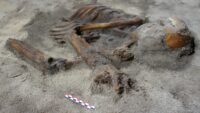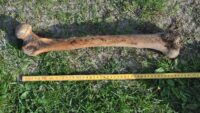 Archaeologists have unearthed a skeleton from the Merovingian era buried on Gimsøya, one of the islands in the Lofoten archipelago of northwestern Norway. An Iron Age farm was known to have active in the area, so when a new campsite was planned near the town of Hov, archaeologists surveyed the site before construction to salvage any cultural heritage materials.
Archaeologists have unearthed a skeleton from the Merovingian era buried on Gimsøya, one of the islands in the Lofoten archipelago of northwestern Norway. An Iron Age farm was known to have active in the area, so when a new campsite was planned near the town of Hov, archaeologists surveyed the site before construction to salvage any cultural heritage materials.
The first evidence of an ancient burial on the premises was discovered in August: a human femur followed by a hip bone. They were in good enough condition to suggest there might be a fully body in the ground. That proved accurate. The team excavated the bottom half of the body first, and then uncovered the top half.
The skeleton was crouched in a fetal-like position, with one arm pulled up towards the head and the other with a clenched fist.
Archaeologists believe the individual was a man, but they are not certain. “The person is clearly not one of those who stood tallest in society, because there is no great decoration, weapons or such things. So far it seems that the individual had an ax, and not much more than that,” said Niemi.
However, it appears the axe is strangely placed: “Right now we are trying to find out if the axe is stuck in the lower jaw or lying next to it.”
 The bones have not been radiocarbon dated yet and the axe can’t be dates, so there were no grave goods that might provide a possible date range. Based on the age of charcoal samples recovered in an associated cultivation layer near the skeleton, archaeologists estimate the burial dates to the Merovingian era, the 8th or 9th century.
The bones have not been radiocarbon dated yet and the axe can’t be dates, so there were no grave goods that might provide a possible date range. Based on the age of charcoal samples recovered in an associated cultivation layer near the skeleton, archaeologists estimate the burial dates to the Merovingian era, the 8th or 9th century.
What makes this modest burial of an unknown individual so unusual is that it somehow managed to survive at all. It’s a total fluke that it wasn’t destroyed over centuries of agricultural use. Just how much of a fluke is underscored by the discovery of plow furroughs not eight inches away from the skull. The area was aggressively exploited in the 1950s and 60s for its rich peat deposits which were bulldozed and stripped away. This person was buried down deep originally, and that extra depth is what saved it from destruction.
All of the findings from the excavation, skeleton and axe included, will be sent to the University of Tromsø for storage and examination.